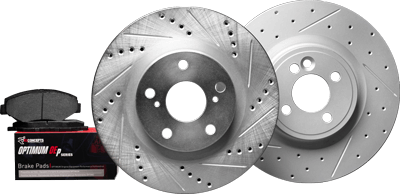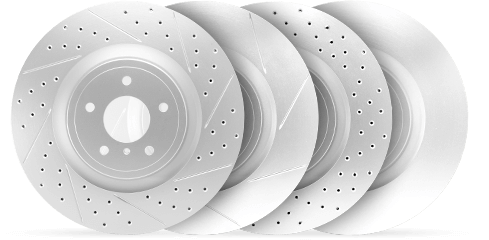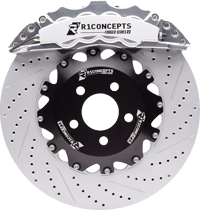Do you hear grinding or feel vibrations when you brake? These may be telltale signs your brake rotors need attention. Learn how to identify worn out brake rotors and get straightforward advice on necessary actions with the experts of R1 concepts, the best OEM brake parts supplier.
Key Takeaways
Early warning signs of worn brake rotors can be mostly identified by sound.
Brake rotors come in various types and lifespans, affected by driving habits, environmental conditions, type of vehicle, and the quality of the rotor and pad.
you just need to do a bit of a driving style change and a few upgrades in order to make the life of your brake rotors longer.
Recognizing the Signs of Worn Brake Rotors
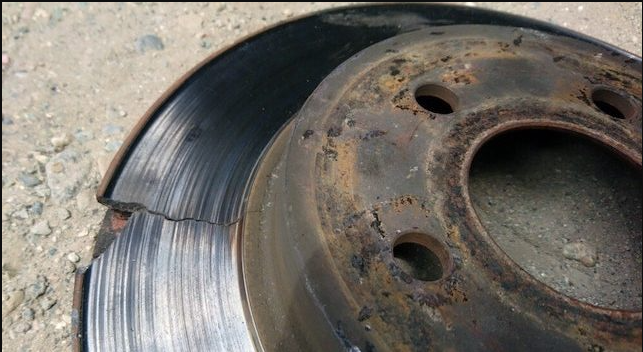
When determining whether your brake rotors are worn or not, one of the most important indication to watch out for are unusual sounds such as grinding, screeching or pulsating noises.
These noises often is an indication of a damaged rotor. Unusual feelings of pulsating or shudder when applying brakes are also one good indication that the brakes are potentially broken.
We’re going to elaborate more about it on the next sections.
Steering Wheel Vibrations
A shaking sensation in the steering wheel while braking is often an early indication of problems with the brake rotors. Uneven brake rotors can cause inaccurate brake clamping, as the brake pads clamp down on these uneven surfaces, the variations in the rotor thickness (also known as rotor runout) can cause the brake pads to move in and out, translating into a vibration that can be felt in the steering wheel
Uneven rotor thickness is typically caused by rust buildup or overheating of the rotors. Rust build up on the rotors can compromise the airflow through the rotors, resulting heat accumulation. The intense heat generated from friction between the brake pads and rotors may cause them to become distorted and deformed, resulting in these unsettling vibrations.
It’s important to have this checked promptly as it may require resurfacing or replacing the rotor. Ignoring this warning sign could compromise your ability to slow down effectively and potentially lead to more serious issues affecting both your braking system performance and safety on the road.
Noisy Brakes
Excessive noise coming from your vehicle’s brakes, specifically if it is a grinding, squealing or vibrating noise is a sign that your rotors are in need of inspection. The noises mentioned could indicate various problems with the brake rotors that require immediate attention.
One of the reasons why the noise happens is because as the brake pads wear down, their metal backing may come into direct contact with the rotor, causing a metal-on-metal grinding noise.
Another reason for noisy brakes can be the presence of debris or small rocks caught between the brake pad and the rotor, which can produce a squealing sound.
Additionally, if the rotors are unevenly worn, or if they have developed grooves and pits, the brake pads may not make smooth, even contact with the rotor surface, leading to noise during braking.
It’s also possible for rotors to make noise if they’ve been exposed to excessive heat and have warped. This warping can cause the rotor to throb against the brake pads as they are applied, creating a pulsating noise.
In some cases, the wear indicator tabs on brake pads will emit a high-pitched screech to alert the driver that the pads are due for replacement, which indirectly indicates that the rotors should be inspected for wear as well.
Regular inspection and maintenance of the brake system, including the rotors and brake pads, is essential for preventing these noises and ensuring safe braking performance.
The Impact of Worn Rotors on Your Vehicle

Worn brake rotors while driving can have significant consequences, such as reduced braking efficiency, accelerated wear of brake pads and potential damage to your vehicle’s brake calipers.
In severe cases, extremely damaged rotor disks can even lead to total failure of brakes during driving causing a major safety threat.
Other than the mentioned above, here are more impacts that we can see.
Longer Stopping Distances
One noticeable effect of worn brake rotors is the increase in stopping distance, which poses a potential safety hazard especially during emergency situations.
As the rotors wear down, their ability to provide friction and even contact with the brake pads decreases, making it more challenging for drivers to bring their vehicle to a quick stop.
Poor contact between the rotor surface and pads can generate excessive heat that may lead to warping of the rotor.
This Exacerbates longer stopping distances and increases braking time.
Damage to Brake Pads and Calipers
Not only does driving with worn rotors affect your braking performance, but it can also lead to damage in other parts of the brake system.
If left unchanged, damaged brake pads can cause deep grooves and scores on the rotor surface that may render it irreparable.
To maintain optimal safety and prolong the life of individual components in a brake system, regular replacement of brake pads is crucial. Neglecting this maintenance could result in warped and worn rotors, which pose a significant risk for potential brakes failure.
Such neglectful actions not only incur high costs but could have easily been avoided through routine check-ups and prompt replacements when needed.
Types of Brake Rotors and Their Uses
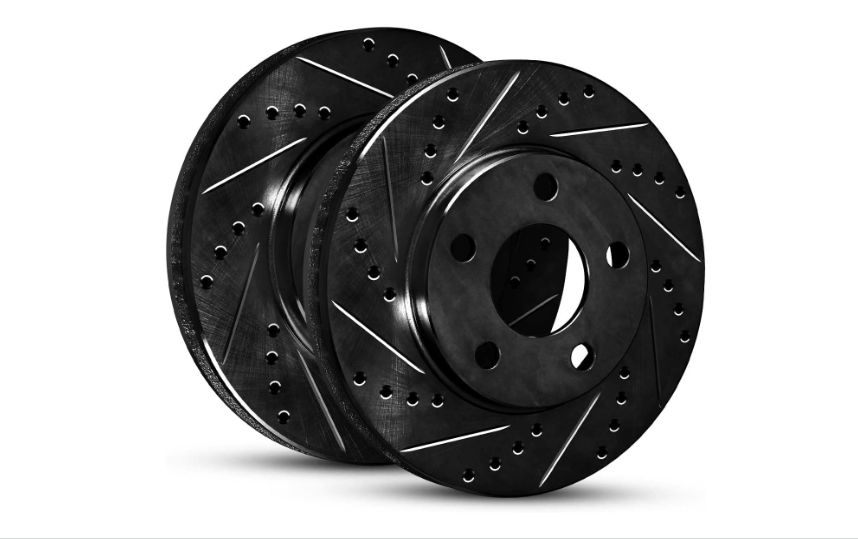
Depending on your driving style and terrain, there is a wide variety of brake rotors available, each with its own unique characteristics and lifespan.
The most common type of rotor found in new passenger vehicles is the plain rotor, which can withstand moderate levels of heat and works well for regular driving.
Drilled rotors have holes that improve braking performance in wet climates, but may wear out faster when exposed to high temperatures. It’s crucial to select the right type of brake rotor for your specific driving needs when considering replacement options.
For heavy-duty trucks and SUVs, slotted rotors are often used due to their durability against cracks as well as improved stopping power by channeling away gas and dust particles.
Another popular option is combining both drilled and slotted patterns on one rotor for enhanced benefits such as effective heat dispersion while maintaining consistent contact with pads. These types tend to have shorter lifespans.
Brake Rotor Lifespan
On average, under normal driving conditions, brakes will need replacing between 30-70 thousand miles. This will vary depending upon factors like driver habits or external environmental conditions faced whilst operating said vehicle. We highly recommend to do this even if the rotors are still in good condition, for better braking performance and to avoid sudden brake problems.
Proper Rotor Maintenance and Replacement
Proper maintenance is crucial for keeping your brake rotors in top shape, beyond simply monitoring them for wear.
You can do the rotor inspection by yourself but if you have concerns about the overall health of your brake system, it is best to seek assistance from a qualified mechanic..
Regular Inspections
Regular checks can prevent potential safety hazards and costly repairs for your vehicle by detecting issues before they escalate.
It is recommended to inspect the thickness of brake rotors every 10,000 miles or when replacing brake pads, with more frequent inspections if any problems are detected.
Visual examinations of brake pads and rotors can detect early signs of wear, making it important to regularly maintain these components along with flushing and changing out old brake fluid. Maintaining good rotor condition not only prevents sudden braking failures, but also preserves optimal performance for your vehicle.
When to Replace or Resurface
Properly maintaining your braking system means knowing when to replace or resurface rotors.
To determine if rotors can be resurfaced, check for significant defects on the friction surface such as cracks, extreme warping, rust, scoring and grooves. Resurfacing helps restore smoothness and effectiveness of the brakes even with early signs of warping without steering wheel shaking.
Rotors must be replaced when they become too thin according to physical thickness measurements. If there is severe damage like deep grooves or cracks observed on a rotor, it may need complete replacement. For consistent performance and safety reasons, it’s best to change all brake pads along with front and rear rotors if one is found worn out.
To find out what minimum level of rotor thickness should not go below, either inspect its engraving manually or refer to vehicle’s service manual.
Preventing Rotor Wear: Best Practices
Preventing rotor wear may be easier than you expect. Good driving habits and the use of high-quality brake pads are key in prolonging the life of rotors. To avoid uneven wear and tear, it is important to steer clear of heavy braking that can lead to overheating and warping of brake rotors. Excessive heat buildup caused by riding on the brake pedal should also be avoided as it accelerates rotor wear.
In order to extend the lifespan of your vehicle’s brakes:
Stay vigilant while driving and anticipate traffic conditions in order to minimize sudden stops.
Reduce unnecessary weight inside your vehicle so as not to put too much demand on brakes.
Invest in top-notch brake pads specifically designed for your particular model for optimal braking performance and longevity.
Understanding Causes of Rotor Wear
There are various reasons for rotor wear, but here are the common ones that cause it:
High heat from frequent braking, especially on long downhills, can cause rotor cracks and warping.
Environmental factors like mud, chemicals, and rough roads contribute to rotor and pad wear.
Rust buildup and manufacturing defects may lead to premature rotor damage.
Heavy loads, mountainous terrain, and aggressive driving increase brake system stress, accelerating wear.
Mechanical issues, such as incorrect lug nut torque or worn brake pads, also affect rotor longevity.
Summary
Proper maintenance of your vehicle’s brake rotors is vital for safety, performance, and the overall longevity of your car. It is important to be able to identify signs of worn rotors, understand their impact on your braking system, and know about different types and how long they last before needing replacement. Regular upkeep and timely replacements are essential practices in ensuring a smooth and safe driving experience. Knowing ways to prevent rotor wear as well as understanding its causes can greatly contribute towards maintaining an efficient braking system for years to come. Remember that just like the engine powers your vehicle forward. Proper brakes keep it safely under control while driving.
Frequently Asked Questions
When Should Rotors Be Replaced?
Replace brake rotors if you notice subtle changes in braking performance, like longer stopping distances or unusual noises during braking. Softness in the brake pedal or minor pedal vibrations may also indicate rotor wear. Regular visual inspections can help catch early signs of discoloration or warping. Consult a mechanic if you’re unsure about your rotors’ condition.
What happens when brake rotors wear out?
As brake rotors wear out, their ability to provide effective braking diminishes due to the loss of a smooth surface. This can result in longer stopping distances and reduced overall braking performance. Ultimately, worn rotors may compromise safe operation.
Is it safe to drive with worn brake rotors?
Driving with worn brake rotors is not a safe practice. This can result in longer stopping distances and reduced braking power, creating hazardous driving situations. It is important to address any issues with your brakes before they become severely worn or damaged. Neglecting proper maintenance of your rotor system could have serious consequences on the overall functioning of your rotor system.
How much should I expect to pay if my rotors need replacing?
The cost of replacing brake rotors varies widely depending on the vehicle type, rotor quality, and labor rates. On average, for a standard vehicle, you can expect to pay between $30 to $150 per rotor for the parts alone. High-performance or luxury vehicles can have rotors costing upwards of $200 to $375 each. Labor costs can range from $150 to $200, depending on the mechanic and the region. It’s always best to get a quote from a trusted mechanic or do some price comparisons to ensure you’re getting the best deal.
How can I prevent rotor wear?
In order to avoid wearing down your rotors, it is advisable to steer clear of abrupt braking, anticipate the flow of traffic ahead, lessen the weight load on your vehicle and utilize top-quality brake pads that are appropriate for the specific make and model of your car. These measures will effectively preserve rotor functionality while also ensuring effective braking capabilities.


